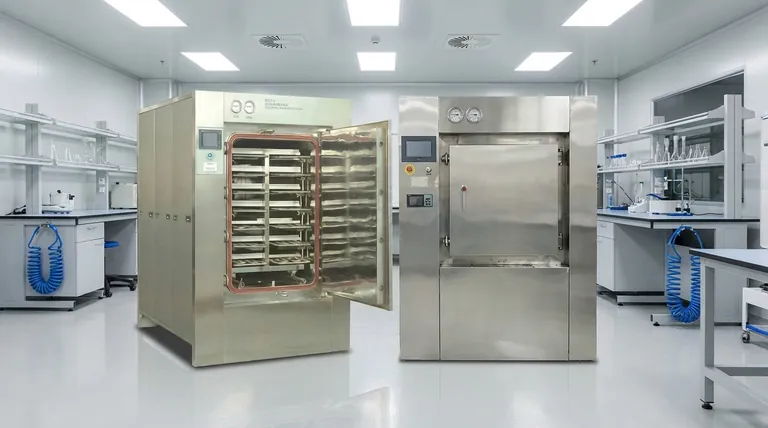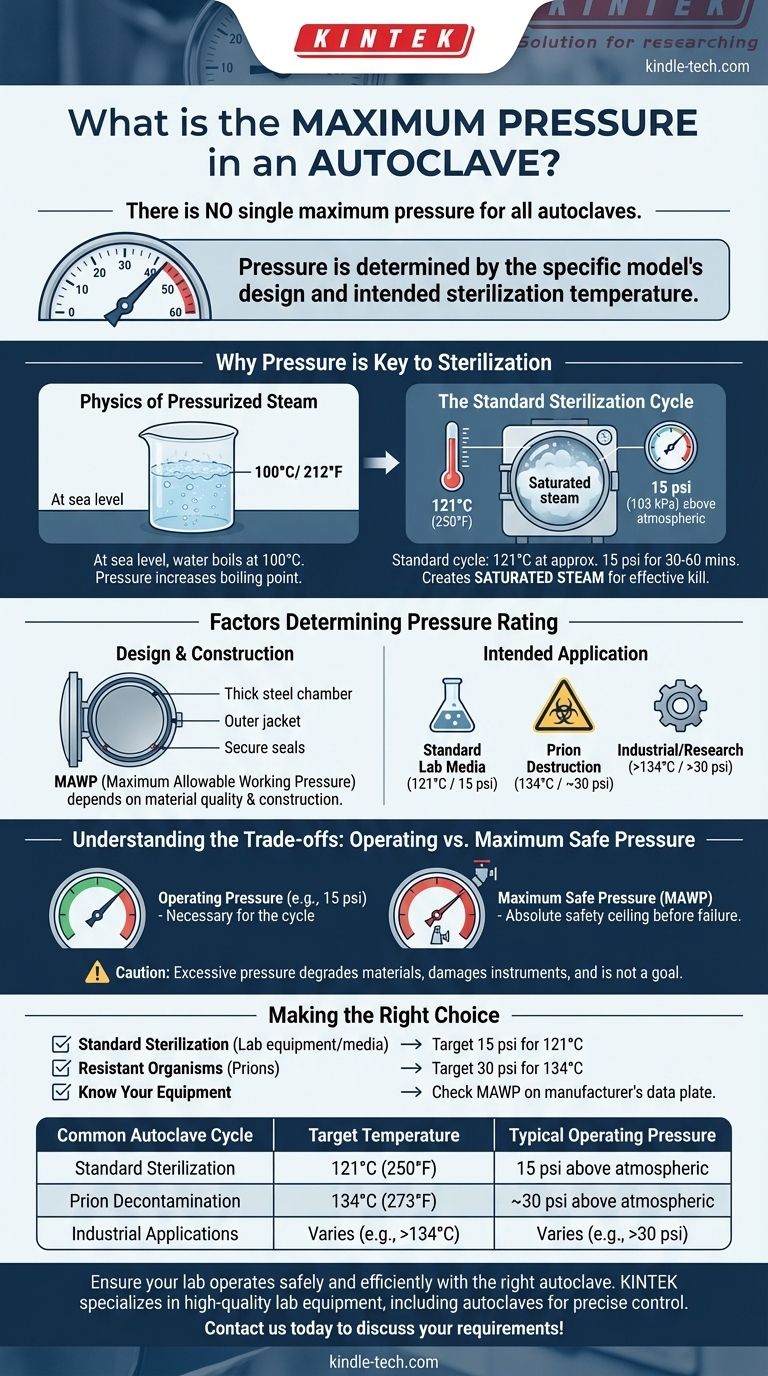There is no single maximum pressure for all autoclaves. Instead, the pressure is determined by the specific model's design and its intended sterilization temperature. For most common applications, autoclaves operate at a pressure of 15 psi (pounds per square inch) above atmospheric pressure to achieve the standard sterilization temperature of 121°C (250°F).
An autoclave’s maximum pressure is a safety rating specific to its construction. The operating pressure, however, is not a goal in itself; it is simply the necessary condition to create the high-temperature saturated steam required for effective sterilization.

Why Pressure is the Key to Sterilization
To understand an autoclave's pressure limits, we must first understand why pressure is used at all. The goal of an autoclave is to kill all microbial life, which requires temperatures that water cannot reach at normal atmospheric pressure.
The Physics of Pressurized Steam
At sea level, water boils at 100°C (212°F). No matter how much heat you add, it won't get hotter.
By increasing the pressure inside a sealed chamber, an autoclave raises the boiling point of water. This allows it to create saturated steam at temperatures lethal to resilient bacteria and spores.
The Standard Sterilization Cycle
The most common and widely recognized sterilization cycle involves heating supplies with saturated steam to 121°C (250°F).
To achieve this temperature, the internal pressure must be raised to approximately 15 psi (103 kPa) above the surrounding atmospheric pressure. This cycle typically lasts 30-60 minutes depending on the load.
Factors Determining an Autoclave's Pressure Rating
While 15 psi is a common operating pressure, the maximum safe pressure of a specific unit can be much higher and depends entirely on its engineering and purpose.
Design and Construction
The core of an autoclave is a pressure chamber, typically consisting of a thick inner chamber made of steel or gunmetal and an outer jacket.
The thickness of these walls, the quality of the steel, and the integrity of the seals dictate the Maximum Allowable Working Pressure (MAWP). This is a safety rating specified by the manufacturer.
Intended Application
Different tasks require different sterilization parameters. While standard lab media is sterilized at 121°C (15 psi), destroying prions (the cause of Mad Cow Disease) may require a cycle of 134°C (273°F), which demands a higher pressure of around 30 psi.
Industrial and research autoclaves used for curing composites or materials science can operate at significantly higher pressures and temperatures.
Understanding the Trade-offs
Focusing only on a "maximum pressure" number can be misleading. The key is to use the correct pressure to achieve the necessary temperature and steam quality for your specific task.
Operating Pressure vs. Maximum Safe Pressure
It is critical to distinguish between the pressure used for a cycle and the machine's safety limit.
The standard 15 psi is an operating pressure. The MAWP is the absolute ceiling the vessel is certified to handle before safety systems, like a pressure relief valve, are triggered to prevent a catastrophic failure.
"More Pressure" Isn't Always Better
Using excessive pressure and temperature can be counterproductive. It can degrade sensitive materials, damage complex instruments, or even cause liquids to boil over when the chamber is vented.
The goal is not to maximize pressure, but to achieve complete sterilization with the minimum necessary heat and pressure to preserve the integrity of the load.
Making the Right Choice for Your Goal
Always prioritize the requirements of the material being sterilized and the safety specifications of your equipment.
- If your primary focus is standard sterilization of lab equipment or media: Your target is almost always an operating pressure of 15 psi to achieve 121°C.
- If you need to destroy highly resistant organisms like prions: You will need an autoclave rated for higher temperatures and pressures, typically operating around 30 psi to reach 134°C.
- If you are purchasing or operating an autoclave: The most important number to know is the Maximum Allowable Working Pressure (MAWP) found on the manufacturer's data plate, not a generic industry standard.
Ultimately, understanding the relationship between pressure and temperature is the key to using an autoclave safely and effectively.
Summary Table:
| Common Autoclave Cycle | Target Temperature | Typical Operating Pressure |
|---|---|---|
| Standard Sterilization | 121°C (250°F) | 15 psi above atmospheric |
| Prion Decontamination | 134°C (273°F) | ~30 psi above atmospheric |
| Industrial Applications | Varies (e.g., >134°C) | Varies (e.g., >30 psi) |
Ensure your lab operates safely and efficiently with the right autoclave. KINTEK specializes in high-quality lab equipment, including autoclaves designed for precise pressure and temperature control. Whether you need standard sterilization or specialized high-pressure cycles, our experts can help you select the perfect solution for your laboratory's needs. Contact us today to discuss your requirements!
Visual Guide

Related Products
- Laboratory Sterilizer Lab Autoclave Herbal Powder Sterilization Machine for Plant
- Laboratory High Pressure Steam Sterilizer Vertical Autoclave for Lab Department
- Portable Digital Display Automatic Laboratory Sterilizer Lab Autoclave for Sterilization Pressure
- Portable High Pressure Laboratory Autoclave Steam Sterilizer for Lab Use
- Desktop Fast Laboratory Autoclave Sterilizer 35L 50L 90L for Lab Use
People Also Ask
- What is the function of autoclave in tissue culture laboratory? Ensure Absolute Sterility for Successful Cell Growth
- What is the most commonly used autoclave? Discover the Industry Standard for Sterilization
- Is an autoclave the same as a steam sterilizer? Understanding the Key to Reliable Sterilization
- What are the do's and don'ts in using autoclave? A Guide to Safe and Effective Sterilization
- What autoclave is used for sterilization? The Definitive Guide to Steam Sterilization



















